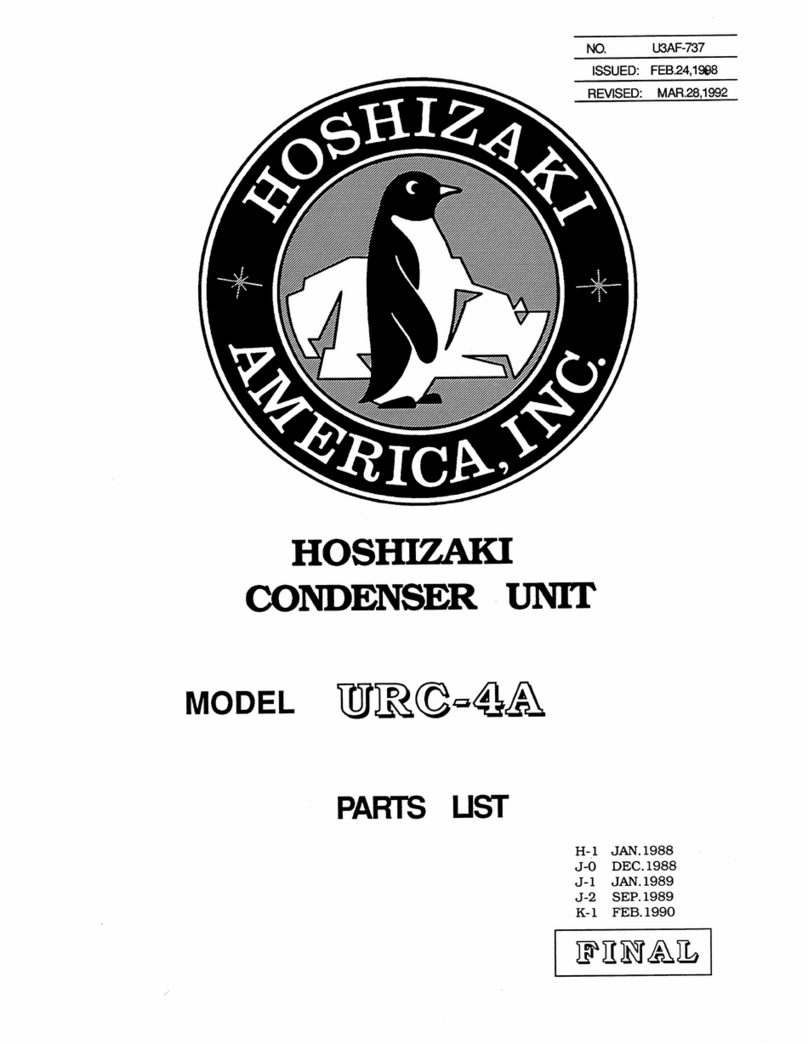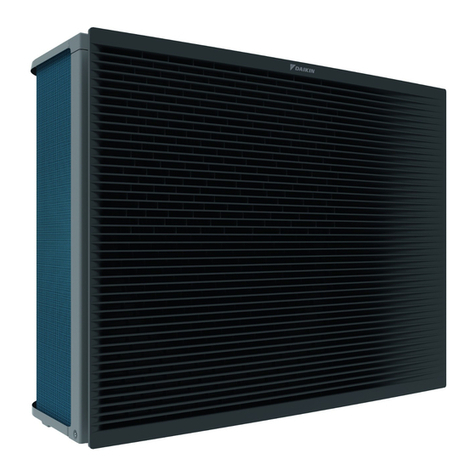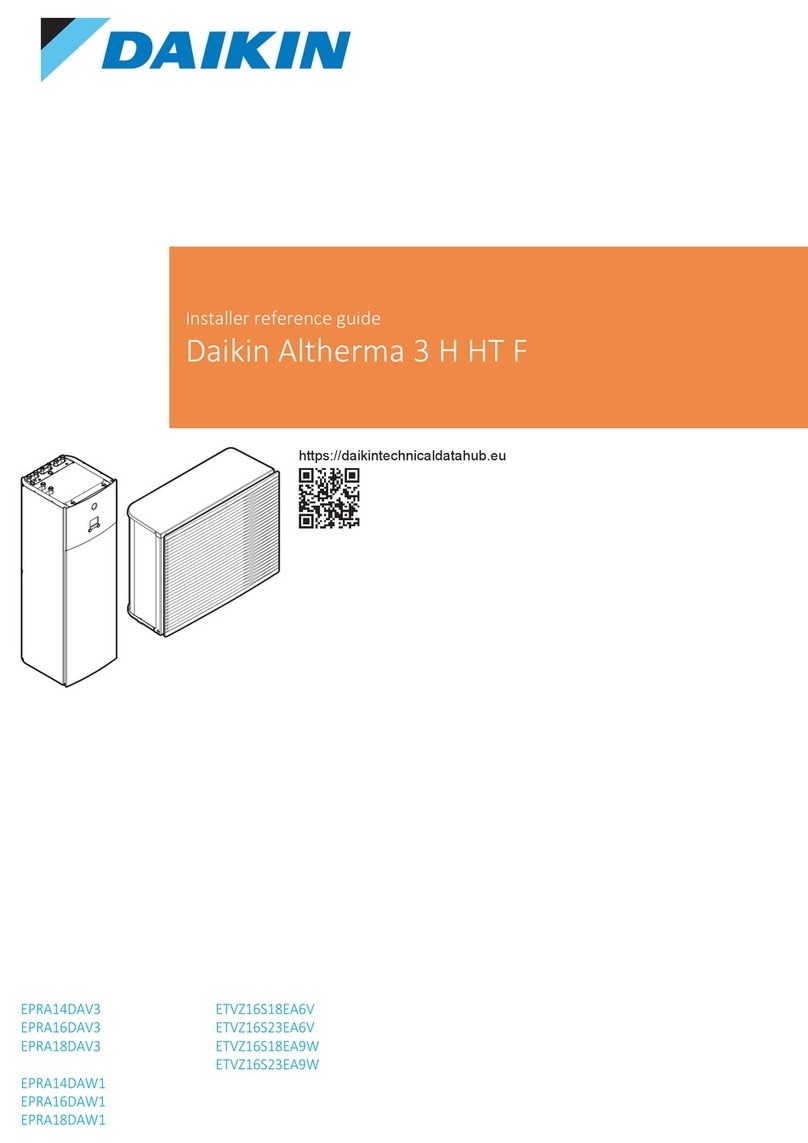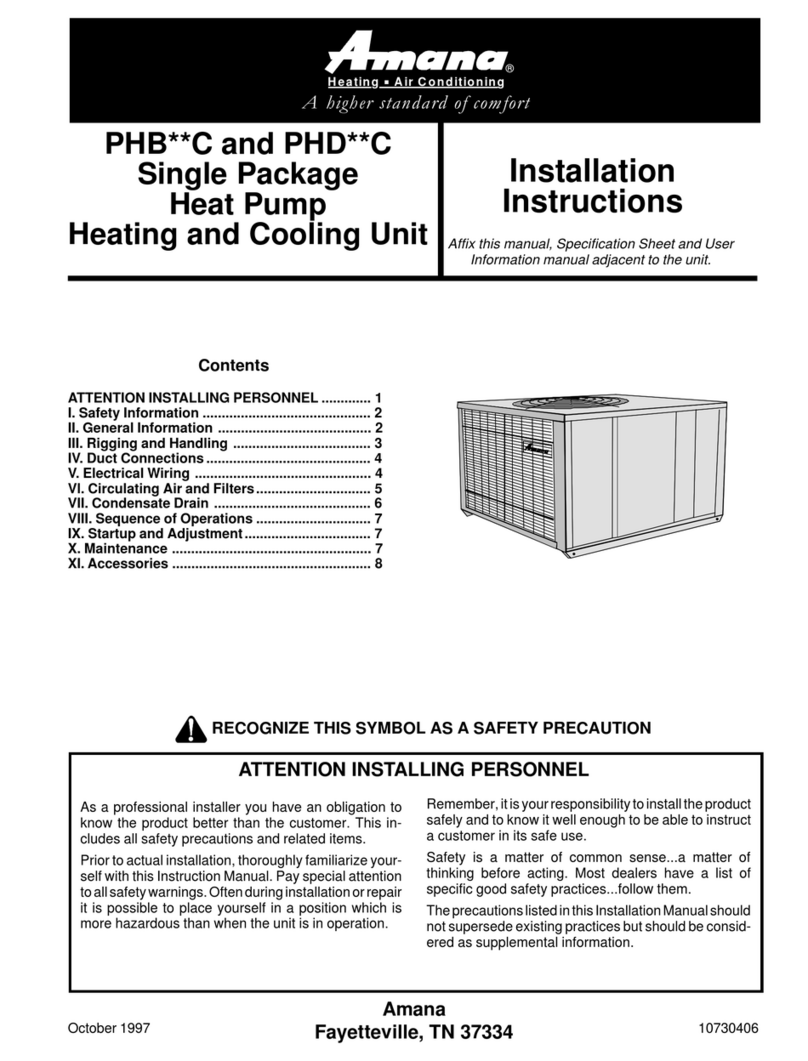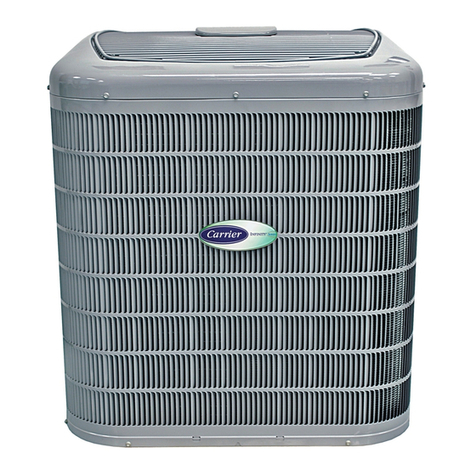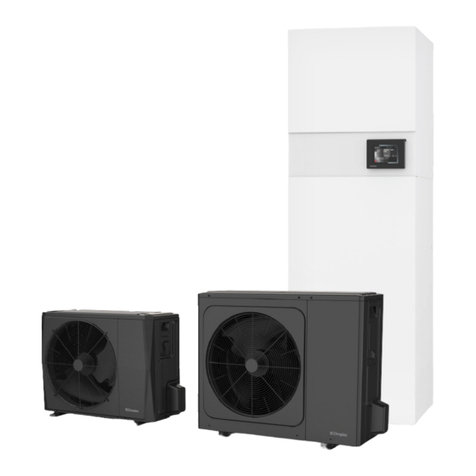ECOGENICA EG-215FR290 User manual

EG-215FR290/EG-215FR290C & EG-290FR290/EG-290FR290C Version: 2C -1/03/23

EG-215FR290/EG-215FR290C & EG-290FR290/EG-290FR290C Version: 2C -1/03/23
▪Do not install this if you cannot ensure that the power supply to the
property is properly grounded.
▪The device must be installed by a licensed professional and must meet the
following conditions:
▪Complies with AS/NZS 3500.4 - "Plumbing and Drainage. Part 4: Heated Water
▪Compliant with control of hot water temperatures
▪AS 4032 AS NZS 3000-Electrical Wiring Rules.
▪Comply with the rules and regulations of the local authority.
▪In line with national building regulations.
▪Local occupational health and safety regulations.
▪Installation shall conform to the Plumbing Code of Australia (PCA)
▪Compliant with Australian Electrical Standard and the AS/NZS 1596:2002
Australian/New Zealand Standard™The storage and handling of LP standards
WARNINGS
Eco Alliance Heat Pump units are subject to different installation regulations across different states in Australia. We will leave the decisions
with you on how to proceed when installing the units ordered to best meet the regulations. Some best practice suggestions are below. They
are only a minimum requirements and not limited to other regulations and practices you need to adhere to.
FOR THE CONTINUED SAFETY OF THIS APPLIANCE, IT MUST BE INSTALLED, OPERATED AND MAINTAINED IN ACCORDANCE WITH THE
MANUFACTURER’S INSTRUCTIONS. PLEASE READ AND UNDERSTAND THIS MANUAL. IF YOU HAVE ANY QUESTIONS, PLEASE CONTACT OUR
LOCAL DISTRIBUTOR.
WARNING Hot water burns! For safety, small children should be supervised around hot water appliances.
Since heat pump water heaters can generate water temperatures more than 50 degrees Celsius, regulations require that a regulating valve be
installed on the hot water outlet lineof the water heater, to prevent the water temperature from exceeding a pre-set safety upper limit.
Water temperatures over 50 degrees Celsius can cause scalding, so care must be taken to ensure that damage is not caused by improper use
of the water heater.
The installation must be performed by an authorized plumber with a gas handling license and maintained within requirements specified in of
The Australian Plumbing Code. In case servicing the electrical or refrigeration systems in the Heat Pump please note, all service and repair
work must be completed in accordance with the Australian/New Zealand Standard™All electrical work should be completed to the relevant
Australian Standards. The following Product Manual is a guide to the best practices regarding technician installation, service, and repair.
A heated water service means the point where the water heater connects to the cold-water service downstream of the isolation valve. Under
no circumstances should "home craft" type modifications be attempted. Children should be supervised by a responsible person to ensure their
personal safety. The system shall be leak-tested on completion of charging but prior to commissioning. A follow up leak test shall be carried
out prior to leaving the site. Before carrying out this procedure, it is essential that the technician is completely familiar with the
equipment and all its details The hot water pump power supply must be protected by a separate circuit breaker on the main power switch
board and rated to suit the size of the components. Do not connect other appliances, especially high-power appliances, to the main power
supply of the water heater, so as not to affect the normal use of the water heater Do not use means to accelerate the defrosting process
or to clean, other than those recommended by the manufacturer. Do not install next to open flames, an operating gas appliance, or an
operating electric heater. Do not pierce or burn piping. Be aware that R290 may not contain an odor. Compliance with national gas regulations
shall be observed.
Compared to common refrigerants, R290 is a nonpolluting natural refrigerant
with no harm to the ozonosphere greenhouse. R290 has got very good
thermodynamic features which lead to high energy efficiency.

EG-215FR290/EG-215FR290C & EG-290FR290/EG-290FR290C Version: 2C -1/03/23
‖Directory Guidelines
The first part: product info 3 -5
The second part: safety info 5- 6
The third part: before installation 7
The fourth part: installation 8-11
The fifth part: debugging 12-13
The sixth part: operation 13-16
The seventh part: trouble removal 16-19
The eighth part: maintenance 19-20
The ninth part: guarantee 21-22

EG-215FR290/EG-215FR290C & EG-290FR290/EG-290FR290C Version: 2C -1/03/23
1‖product info
1.1 Introduction
Your Ecogenica 215 and 290 FR models are ground-breaking integral quick connect, direct heat transfer, Heat Pump Heating
technology. That means Ecogenica is more reliable and energy efficient. And the innovation in our split condenser tank design
is at the forefront of the industry right now. Designed and developed in Australia for Australian conditions by our design team
who have been designing the most energy efficient Heat Pumps for more than 30 years.
Circulation pumps, and troublesome heat exchangers are not used, so fewer moving parts and no heat exchanger maintenance
is required, making this a more reliable and resilient design compared to other heat pump water heater available. Your very
high energy efficiency means superior energy saving compared to other Heat Pump Water Heaters. The Coefficient Of
Performance (COP) of 4.8 means that for every 1 kW of power used from the grid (or from your solar power system) the Heat
Pump put into the water 4.8 kW of effective power, by extracting heat energy from air. The Ecogenica 215 and 290 models
are fully dedicated Heat Pumps and use the most advanced Reverse Cycle Heating Technology to heat the water instead of the
air. The large surface area incorporated into the heat pump design means the Ecogenica does not need a heat element and will
continue to extract heat from the air even in freezing weather.
Litres
Model #
Suitable
for
(people)
Tank Size (mm)
Heat Pump Size (mm)
Heating
Capacity
(kW)
H
W
H
W
D
215
EG-215FR290
1-4
1815
510
545
780
276
3.4
215
EG-215FR290C
1-4
1815
510
545
780
276
3.4
290
EG-290FR290C
3-7
1815
510
545
780
276
3.4
290
EG-290FR290
3-7
1815
510
545
780
276
3.4
430 (2x215L)
EG-215FR x 2
7+
1815
510
545
780
276
6.8 (2x3.4)
1.2 How does it work?
The secret to this physical process is the use of the naturally very cold R290a natural gas, which absorbs heat energy as it
passes through the large heat pump fin coil. As the gas passes through the fin coil heat from the air turns the cold low pressure
R290 vapor into a high-pressure gas, which then passes through a high efficiency rotary compressor, becoming super-heated.
The Super-heated gas passes through a heat jacket which is wrapped around the water cylinder and once the gas loses heat
energy to the water it turns back into a cold vapor and the cycle continues until the water is piping hot. You can expect the
tank to heat up between 1 and 4 hours, wind, rain, snow, and summer.
The compressor compresses the gas, just like a bicycle pump (if you put your finger on it), and like the bicycle pump the gas get
hot. The hot high-pressure gas then passes through the Micro-Channel condenser, which is located on the steal water heater.
The Micro Channel Jacket heats the cylinder like an element heats a vitreous enamel frying pan. The Micro Channel Condenser
Jacket is on the skin of the steel water cylinder under an inch of highly insulating foam, so the heat has nowhere to go except
into the water. Best of all this means the jacket never encounters the water, and the direct heating process is more reliable
and efficient than other heating technologies.
1.3 Natural Refrigerant
Ecogenica is at the forefront of Natural Refrigeration use, for a cleaner environment. Refrigeration mechanics are not required during
installation, as the heat pump uses natural gas found commonly in the environment. R290a is (LPG) propane and as only 500 grams of
propane is in the sealed system the heat pump contains just a fraction of that contained in a typical LPG BBQ bottle. To realize the
function of the heat pump unit, a special refrigerant circulates in the system. The used refrigerant is R290, which is specially developed
for Heat Pump use. The refrigerant is flammable and odorless. Furthermore, it can lead to explosions under certain conditions. But the
flammability of the R290 natural refrigerant is very low and it can be ignited only by fire. Technicians must always turn on a
combustible gas detector when entering the service area and make sure equipment power cords are unplugged or disconnected safely,
as sparks from unplugging, or power disconnects could ignite flammable refrigerants. Service must also be performed in a well-
ventilated area, especially if the refrigerant system is being accessed.

EG-215FR290/EG-215FR290C & EG-290FR290/EG-290FR290C Version: 2C -1/03/23
1.4 diagram
260mm 780mm
545mm
1.5 components
505mm 288mm
Top cover
plate
ControllerAssembly
Rear Fence
Axial-flow motor
Evaporator
Four-way
reversing valve
Electronic
expansion valve
Compressor
Chassis
Middle
baffle
Air Net (wire) Front panel Wind blade Motor bracket
Stop Valve
Right coaming

EG-215FR290/EG-215FR290C & EG-290FR290/EG-290FR290C Version: 2C -1/03/23
1.6 tank (mm)
EG-215FR290 / EG-215FR290C EG-290FR290 / EG-290FR290C
1.7 Parameters
Model
EG-215FR290 / EG-215FR290C
EG-290FR290 / EG-290FR290C
Thermal capacity
3400W
3400W
Average input power
700W
700
COP
4.85W/W
4.85W/W
Max power input
1150W
1150W
Circuit Breaker Size
5.0A
5.0A
Refrigerant type
R290
R290
Mass volume
500g
500g
Running ambient air temp.
-7~+40℃
-7~+40℃
Maximum outlet water temperature
70℃ (1℃step)
70℃ (1℃step)
Product weight
36kg
36kg
Tank weight
70kg
85kg
Design Pressure (High)
3.0MPa
3.0MPa
Protection Raining Class
IPX4
IPX4
Rated pressure of water tank
850kPa
850kPa
Rated Pressure
500kPa
500kPa
PTR Valve
850kPa
850kPa
PTR valve power capacity
10kW
10kW
Test condition:
Default setting: 55 ℃Test conditions: outlet water temperature 55 ℃, inlet water temperature 14 ℃,
dry bulb temperature 19 ℃, wet bulb temperature 15 ℃。

- 1 -
EG-215FR290/EG-215FR290C & EG-290FR290/EG-290FR290C Version: 2C -1/03/23

- 2 -
EG-215FR290/EG-215FR290C & EG-290FR290/EG-290FR290C Version: 2C -1/03/23
1-8 circuit diagram
○
1
○
2
○
3
Integrated Circuit Board
Transformer
Display
○
10
Low-pressure switch
○
11
Electronic expansion valve
○
12
Four-way reversing valve
○
4
Water tank temperature sensor
○
13
Motor
○
5
Exhaust Temperature Sensor
○
14
N/A
○
6
Ambient Temperature Sensor
○
15
Compressor
○
7
Gas recovery temperature sensor
○
16
Motor capacitance
○
8
Coiler temperature sensor
○
17
Compressor startup capacitor
○
9
High-pressure switch
○
18
Connection terminal station
Water tank temperature

- 3 -
EG-215FR290/EG-215FR290C & EG-290FR290/EG-290FR290C Version: 2C -1/03/23
2‖safety info
The following safety warnings are very important, always read and obey all safety signs:
warning
•Operation without water in the water tank may cause the water heater to enter a protection state, which
may damage components in severe cases.
•This Heat Pump must be effectively grounded. RCD circuit breaker must be installed. Do not remove, cover, or damage
any permanent instructions or labels from the exterior or interior of the unit panel.
•Only qualified personnel should install in accordance with local and national regulations and this guide. Improper installation
may cause water leakage, electric shock, or fire alarm.
•All electrical connections must comply with the requirements of the local power company, the local power company, and
this guide. Do not use a rated fuse, otherwise it may malfunction and cause electrical fire.
•Do not insert fingers, rods or other objects into the air inlet or outlet. The fan is rotating at high
speed, which may cause injury. Do not use flammable sprays, such as hairspray or paint, near the
machine to avoid fire.
•Disposal: Do not dispose of electrical appliances as unsorted municipal waste, A separate collection
facility should be used. Contact your local government to find out Information about the collection
system. If electrical appliances are disposed of at landfills or dump sites, hazardous substances can seep into groundwater
and cause health problems question.
•The unit must be fixed firmly, otherwise noise and vibration may be generated.
•Make sure there are no obstacles around the device. In places with strong wind (such as seaside
areas), the unit should be installed in a windproof place.
•The PTR valve is operated every 6 months to ensure that the valve does not have any restrictions.
•And it should be well insulated to prevent the water in the pipe from freezing in cold weather.
cautious
•The ground electrode must be well grounded. Make sure all electrical sockets and plugs are dry and tightly connected.
•Before cleaning the Heat Pump, be sure to stop operation and isolate the unit (i.e., turn off the isolating switch or
circuit breaker). Otherwise, electric shock and injury may occur.
•Water temperature over 50 degrees Celsius will cause severe burns and even death.
Children, the disabled and the elderly are at the highest risk of burns. In the bath or
feel the water temperature with your hands before showering to avoid burns.
•Do not operate the machine with wet hands to avoid electric shock.
•A one-way check valve and a suitable isolation valve must be installed on the water inlet side.
•It is normal for the one-way safety valve to release some water during operation. However, if there is a large amount of
water, please contact our service team. Arrange drainpipes to ensure efficient drainage. Improper drainage can cause water
damage to surrounding areas such as buildings, furniture etc.
•Except for repair and maintenance purposes, do not turn off the power, especially in cold weather, as it may freeze the
machine when the power is turned off. Continuously powered heating Water is necessary.

- 4 -
EG-215FR290/EG-215FR290C & EG-290FR290/EG-290FR290C Version: 2C -1/03/23
3‖before installation
3-1 disassemble
When unpacking, make sure that the items in the accessories list are complete, and whether the model of the main
unit and the water tank are correctly matched.
3-2 transport
•When shipping this item, the following rules must be followed:
•When moving, do not make the fuselage deviate from the vertical angle by
more than 25 Degrees keep vertical.
•To avoid scratches or damage, please use protective covering where applicable.
•Since the machine is heavy, it needs two or more people to
carry it, to avoid injury and/or damage.
3-3 position requirement
When choosing a suitable location, the following factors should be considered:
•It is essential that electrical power is available before the task commences.
•Ensure that there is enough space for installation and future maintenance.
•The inlet and outlet should be free of obstacles and strong winds.
•The bottom surface should be flat (i.e., no more than 2° inclination), and can bear 3 times the weight of the machine,
while ensuring that no noise and/or vibration will be increased.
•The running noise and the exhaust airflow should not affect other people.
•Make sure there is open no flame nearby.
•The installation location should be convenient for piping and wiring.
•Installation indoors may cause indoor temperature fluctuations and excessive noise.
•Ensure that the electrical insulation complies with the relevant local standards.
•The ventilation should safely disperse any released refrigerant and preferably expel it externally into the atmosphere.
•Prior to beginning work on, safety checks are necessary to ensure that the installation complies with relevant Australia
Plumbing Codes.
•The area shall be checked with an appropriate refrigerant detector prior to and during work, to ensure the technician is
aware of potentially toxic or flammable atmospheres.
cautious
The ambient air temperature must also be considered, the heat pump will not operate efficiently in temperature below
5 degrees, so day time operation should be considered and settings on the timer should be selected to provide adequate
operation to heat the water. If it is installed in closed spaces such as garages and basements, there must be unrestricted
air flow (such as installing a strong exhaust fan) to prevent freezing. Installing this unit in any of the following locations
may cause malfunction (consult your representative before purchasing):
oSeaside areas or places with salt in the air.
oHot spring areas with corrosive gases (e.g., sulfides).
oFactories with large voltage fluctuations.
oIn a cabin without a large enough exhaust system.
oPlaces exposed to direct sunlight or other sources of high heat should be avoided and protection from direct
sunlight (i.e. awnings should be considered).
oAreas with strong electromagnetic fields.
oAreas where flammable gases or materials are present.
oAreas where acidic or alkaline gases are present.

- 5 -
EG-215FR290/EG-215FR290C & EG-290FR290/EG-290FR290C Version: 2C -1/03/23
4‖The installation
4-1 Piping drawing
notice
•Cold water inlet and hot water outlet are 3/4-inch (20mm) female connections.
•The outlet of the PTR valve is a 3/4-inch (20 mm) female fitting.
•Supply outlets installed are either supplied in the Eco Alliance Quickie kit, or be an approved fixture as specified in the
relevant Australian code and all installations must be completed to relevant Plumbing standards and meet relevant
Performance Requirements and be compliant with documents such as AS/NZS3500.4 and the Australian Plumbing Code.
•Install a one-way valve at the water inlet of the water tank as described in the Australian Plumbing Code.
•All hot water pipes must have lagged that reduces heat losses to the highest standard.
cautious
•If the outdoor temperature is lower than 5 degrees Celsius during installation, insulation protection must be provided for
hydraulic components (i.e., pipes).
•If the water inlet pressure is less than 150 kPa, a booster pump should be installed at the water inlet.
•To ensure the safe use of the water tank, when the water inlet pressure exceeds 500 kPa, a pressure reducing valve
should be installed on the water inlet pipe.
warning
•Do not disassemble the PTR valve.
•Do not block the condensate drain line.

- 6 -
EG-215FR290/EG-215FR290C & EG-290FR290/EG-290FR290C Version: 2C -1/03/23
≥
4-2 Install position
Install properly spaced air circulation and duct passages wall upper wall
≥300mm
300mm
Air
outlet
1. Installers need to firstly put the tank and condenser in place. The installer needs to work out the best layout strategy for the
pipe and consider all site issues before lowering the condenser pipes.
2. Place the device on a flat, firm surface capable of bearing 3 times the weight of the
device.
3. Locate the Heat Pump (Evaporator) within 2m from the Condenser Tank.
4. If there is no special drainage pipe (sink), be sure to ensure that the condensed water
flowing on the ground can be drained smoothly to avoid water pooling around the heat
pump. As condensate will otherwise drip from the appliance onto the floor if the
drainpipe is not added.
5. Please do not pile up obstacles onto the Heat Pump, as they may affect the smooth air
circulation (Should avoid the windward direction).
6. The outdoor unit (Heat Pump) is installed with a 25mm high rubber shockproof, and it
is firmly fixed with studs to avoid noise when the machine is running.
4-3 Water tank installation position
1. The water storage tank must be placed upright on ground, with a 10cm foot pad under it.
2. The installation site has a solid foundation and must be able to withstand a weight of more than 500kg. The tank should not
be hung on the wall.
3. If the water storage tank is installed outdoors, in tropical climates, subject to server weather, please bolt firmly to protect
against typhoon type weather.
4. Never install the wall bracket mounting support on the external walls of living areas, or bedrooms, as this may cause
vibration type noise. Install the wall mounting support on a garage wall, for example.
4-4 Pre-charged refrigeration pipes
Connect the pre-charged refrigeration pipes using the (1/8”to 1/4") quick connect adapter supplied with the unit (in the quickie kit).
The working fluid pipe: gas pipe is 3/8”(φ9.52), liquid pipe ¼”(φ6.35)].

- 7 -
EG-215FR290/EG-215FR290C & EG-290FR290/EG-290FR290C Version: 2C -1/03/23
4-5 Connecting the couplings:
The EG Series comes standard with pre-charged 2-meter refrigeration lines for ease of
installation and to prevent leaks.
Procedure for connection of the condenser pipe to tank:
1. Remove the packaging and carefully lower the refrigeration lines towards the heat
pump. Connect the pre-charged refrigeration pipes using the (3/8" to l/4') quick
connect adapter supplied with the unit (in the quickie kit)
2. Guide the refrigeration line onto the female refrigeration quick connect adapter and
prepare to screw the male coupling to the female coupling.
3. When connecting the water tank, please check whether the sealing nut of the water
tank has fallen off, otherwise, use high-pressure nitrogen to clean the fluorine system
channel.
4. Once pressure is applied to the spanner the single use, one-shot coupling is folded back into the coupling, providing a high
flow path and low pressure drop for the refrigeration charge in the condenser pipe (located on the water tank) to combine
with the heat pump charge.
5. The couplings are connected and the refrigeration charge in the condenser pipe is released into the heat pump and the fully
charged heat pump is ready for plumbing connections.

- 8 -
EG-215FR290/EG-215FR290C & EG-290FR290/EG-290FR290C Version: 2C -1/03/23
Residential installation
Notes:
Small commercial installation
Notes:

- 9 -
EG-215FR290/EG-215FR290C & EG-290FR290/EG-290FR290C Version: 2C -1/03/23
4-6 Custom installations
If any customization is required, for example the pipes are to run under ground, through wall cavities, or walls, or to a heat pump on a
roof, or bracket located above the tank; then a refrigeration mechanic should be arranged to complete the tank and heat pump
connection, to the relevant Australian Standard.
Eco Alliance must also be notified, and approval must be secured from the Service Managers.
Extension pieces can be purchased, and this will enable an installer to extend the pre-charged connection by up to 5 meters.
If extension pieces are purchased, because the tank and heat pump need to be further apart than the standard 2-meter condenser
pipe will permit, these extensions must be purchased in advance. Installers must contact Eco Alliance to secure approval for any
customized installation layouts
4-7 Electrical connections
● Electrical installation work may only be carried out by a licensed electrician in accordance with the relevant regulations on
electrical safety and electrical wiring.
● Follow the wiring rules for circuit breaker rating are 20 AMPS, any installation under 20AMPs requires an RCBO to be connected
● The machine should use a special power supply, and the voltage should meet the rated voltage ±10%
●The power supply circuit of the machine must have an effective ground (earth) wire, and the power ground wire must be reliably
connected to the external ground wire.
● Power cables and signal cables should be arranged neatly and reasonably. Strong and weak cables should be separated from each
other, and they should not interfere with each other. Otherwise, the normal state of the display will be affected.
● Please arrange the power supply layout reasonably and avoid splicing wires.
● Do not disconnect or disassemble the ground wire of the power supply under any circumstances; do not use damaged wires and
switches and replace them immediately if they are found to be damaged.
Please refer to the table below
power
specification
Wire
diameter
switch
Leakage protector
220V~240V
2.5mm
2
20A
30mA

- 10 -
EG-215FR290/EG-215FR290C & EG-290FR290/EG-290FR290C Version: 2C -1/03/23
5‖Commissioning the system
5-1 Preparation before operation….
Before trial operation, please follow these steps before starting the machine, please confirm the following items, and
mark them in the box after confirmation √
Trial run check list:
● Correct installation ● The power supply voltage is consistent with the rated voltage of the unit
● Piping and wiring are correct●The air inlet and outlet of the unit are barrier-free
● Drainage and emptying are smooth without leakage ● Leakage protector works effectively
● Plumbing installed correctly ●Grounding is valid
5-2 System debugging
A trial run must be done after all installations are complete. Operation without water in the water tank may cause the
water heater to enter a protection state, which may damage components in severe cases. Failure to run the heater
without water, the manufacturer will not be responsible for any damage caused by this issue.
5-3 turn on power
cautions
•Before turning on the power to the unit, double-check that the water tank is full of water.
•After confirming that the power cord is firmly connected, turn on the power of the water heater.
•No need to operate the display, the display is in the power-on state by default.
•The device has a three-minute delay start function, please be patient. After running for 30 minutes, observe the running
status.
•If there is any problem, please check the display. The fault code displayed on the screen and timely feedback.
•The device is fully automatic control, according to the selected method and the surrounding environment, the set water
temperature, self-adaptive adjustment, heating the stored water to target temperature.
•At all times the manufacturer’s maintenance and service guidelines shall be followed. If in doubt, consult the manufacturer’s
technical department for assistance.

- 11 -
EG-215FR290/EG-215FR290C & EG-290FR290/EG-290FR290C Version: 2C -1/03/23
5-4 Electrical Services Guide
•The electrical components such as the fan motors, overloads, and start device are sealed to prevent them from igniting R-
290. However, all service work should be conducted only after approval from Eco Alliance has been secured.
•All service and repair work must be completed in accordance with relevant Australian Electrical Standard and the AS/NZS
1596:2002 Australian/New Zealand Standard™The storage and handling of LP standards and all other relevant Australian
Standards.
•If it is necessary to have an electrician provide servicing, the electrician must not work on Heat Pump components, or circuits,
until inspected by an Eco Alliance approved technician, to ensure that no leaks are present.
•It’s recommended that service agents contact Eco Alliance, Phone 1300 341 010 to gain approval for the heat pump to be
disconnected and returned to Eco Alliance; instead of conducting electrical works on components and circuits contained
withing the Heat Pump.
•If the system has been identified as having a gas leak, then the Eco Alliance approved technician must ensure that the Heat
Pump has been evacuated.
•Once approval for onsite repairs has been secured from Eco Alliance, repair and maintenance of electrical components
shall include initial safety checks and component inspection procedures.
•If the fault in the power supply cannot be corrected immediately, but it is necessary to continue operation, an adequate
temporary solution shall be used. This shall be reported to the owner of the equipment, so all parties are advised.
•If during service and repair, the capacitors mustbedischarged to avoid electrical shocks. This should be done in a safe manner
to avoid the possibility of electrical sparks. Inspect that no live electrical components and wiring are exposed while charging.
•Particular attention shall be paid to ensure that by working on electrical components, the protective casing on all electrical
components is not altered in such a way that the level of protection is affected. This shall include damage to cables, excessive
number of connections, terminals not made to original specification, damage to seals, incorrect fitting of glands, etc.
•Ensure that seals or sealing materials have not degraded to the point that they no longer serve the purpose of preventing the
ingress of flammable atmospheres. Replacement parts shall be in accordance with the manufacturer’s specifications.
•Do not apply any permanent inductive or capacitance loads to the circuit without ensuring that this will not exceed the
permissible voltage and current permitted for the equipment in use. The test apparatus shall be at the correct rating.
•Check that cabling will not be subject to wear, corrosion, excessive pressure, vibration, sharp edges, or any other adverse
environmental effects. The check shall also consider the effects of aging or continual vibration from sources such as
compressors or fans.
•If any hot work is to be conducted on the refrigerating equipment or any associated parts, appropriate fire extinguishing
equipment shall be available to hand. Have a dry powder, or CO2 fire extinguisher adjacent to the charging area.
•All possible ignition sources, including cigarette smoking, should be kept sufficiently far away from the site of installation,
repairing, removing and disposal, during which refrigerant can possibly be released to the surrounding space.
•Prior to work taking place, the area around the equipment is to be surveyed to make sure that there are no flammable
hazards or ignition risks.
•“No Smoking”signs to be displayed if risk of contact with the public in the immediate area of the system.

- 12 -
EG-215FR290/EG-215FR290C & EG-290FR290/EG-290FR290C Version: 2C -1/03/23
5-5 Refrigeration Service Guide
•All service work should be conducted only after approval from Eco Alliance has been secured and service and repair
technicians must be aware of Eco Alliance repair and service procedures.
•In case of a refrigerant leak all service and repair work must be completed in accordance with the AS/NZS 1596:2002
Australian/New Zealand Standard™The storage and handling of LP standards and all other relevant Australian Standards.
•No person carrying out work in relation to a refrigerating system which involves exposing any pipe work shall use any
sources of ignition in such a manner that it may lead to the risk of fire or explosion.
•It’s recommended that service agents contact Eco Alliance, to gain approval for the heat pump to be disconnected and
returned to Eco Alliance; instead of conducting refrigeration and electrical works on components and circuits contained
withing the Heat Pump.
•If in a commercial or industrial setting, then all maintenance staff and others working in the local area shall be instructed in
the nature of the work being carried out. Work in confined spaces shall be avoided.
•It is recommended good practice that the R290 Natural gas systems are not recovered. As they are flammable caution
must be taken to ensure sparks and open flame is not close to the service site.
•All refrigerants are if not R290 must be recovered safely. Prior to the task being carried out, ensure that:
1. Recovered refrigerantshall not be charged into anotherrefrigeratingsystem unlessit has been cleaned and checked.
2. Equipment shall be labelled stating that it has been de-commissionedand emptied of refrigerant.
3. The label shall be dated and signed
4. Ensure that there are labels on the equipment stating the equipment contains
•Ensure that the leak detection equipment being used is suitable for use with all applicable refrigerants, i.e., non-
sparking, adequately sealed or intrinsically safe.
•Recovering or purging the system must comply with all relevant Australian Codes. During repairs to sealed
components, all electrical supplies shall be disconnected from the equipment being worked upon prior to any
removal of sealed covers, etc.
•Ensure that the detector is not a potential source of ignition and is suitable for the refrigerant used. Leak
detection equipment shall be calibrated to the appropriate percentage of gas. Electronic leak detectors may be
used.
•If a leak is suspected, all naked flames shall be removed/extinguished. If a leakage of refrigerant is found which
requires brazing, all the refrigerants shall be recovered or removed from the system.
•When breaking into the refrigerant circuit to make repairs –or for any other purpose –conventional procedures
shall be used, for flammable refrigerants, it is important that best practice is followed since flammability is a
consideration.
•If recovery equipment is used ensure it is in good working order with a set of instructions concerning the
equipment that is at hand and shall be suitable for the recovery of flammable refrigerants.
•Check that it has been properly maintained and that any associated electrical components are sealed to prevent
ignition, in the event of a refrigerant release. Consult manufacturer if in doubt.
•If compressors or compressor oils are to be removed, ensure that they have been evacuated to an acceptable
level to make certain that flammable refrigerant does not remain within the lubricant. The evacuation process
shall be carried out prior to returning the compressor to the suppliers. When oil is drained from a system, it
shall be carried out safely.

- 13 -
EG-215FR290/EG-215FR290C & EG-290FR290/EG-290FR290C Version: 2C -1/03/23
5-6 Machine running dynamics
There are different heating times at different ambient temperatures.
Typically, lower ambient temperatures result in longer run times.
COP
Changes in ambient temperature and heating capacity Changes in ambient temperature and energy efficiency ratio
Note: The above data is measured in the laboratory to simulate the ambient temperature and humidity. If it is different
from the actual ambient temperature and humidity, this data is for reference only.
5-7 Protection method
When the self-protection mode is activated, the system will stop and start self-checking. Once the error is resolved, the
unit will restart. When the self-protection mode is activated, the error code will be displayed on the screen until the error
is resolved.
•The device can enter self-protection mode under various conditions, including but not limited to:
oBlocked air inlet or outlet.
oThe evaporator is covered with too much dust.
oThe unit receives incorrect power (over the 220-240v range)
5-8 Natural Refrigerant addition
The working medium pipe equipped with the main engine is the base length. When the length exceeds the base
standard length, the refrigerant must be added strictly according to the length of the working medium pipe.
Additional refrigerant is required. Please follow the table below, adding will affect the performance of the unit
Refrigerant addition
record
0.015kg/m×(L-base length)
Note: L is the length of the double-pass working fluid tube, in mm. After adding, please
record the final charging amount and keep it properly for subsequent maintenance.

- 14 -
EG-215FR290/EG-215FR290C & EG-290FR290/EG-290FR290C Version: 2C -1/03/23
6‖System operation
6-1 display
1
Lock: (this function is blocked)
If the control panel is locked, the lock icon will be displayed on the screen
2
AUTO
Auto Mode:
If auto mode is selected, this icon will be displayed on the screen
3
ECO
Economic model:
This icon will be displayed on the screen if the economy mode status is selected
4
STANDBY
Insulation:
If the machine stops working when the water temperature has reached the set temperature, this icon
will be displayed on the screen
5
HEAT
Heating:
This icon will be displayed on the screen when the machine is on and working to produce hot water
This manual suits for next models
4
Table of contents
Other ECOGENICA Heat Pump manuals
Popular Heat Pump manuals by other brands
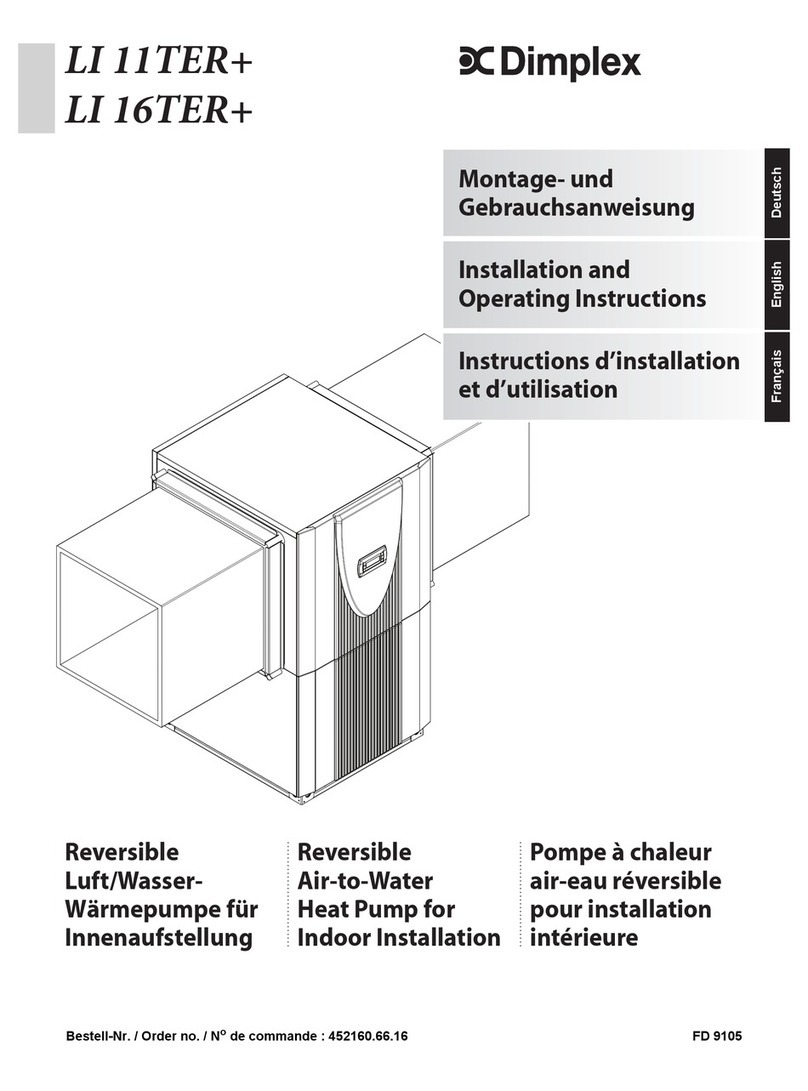
Dimplex
Dimplex LI 11TER+ Installation and operating instructions

Daikin
Daikin ERQ125A7W1B installation manual

Wolf
Wolf BWL-1 S Installation and operating instructions
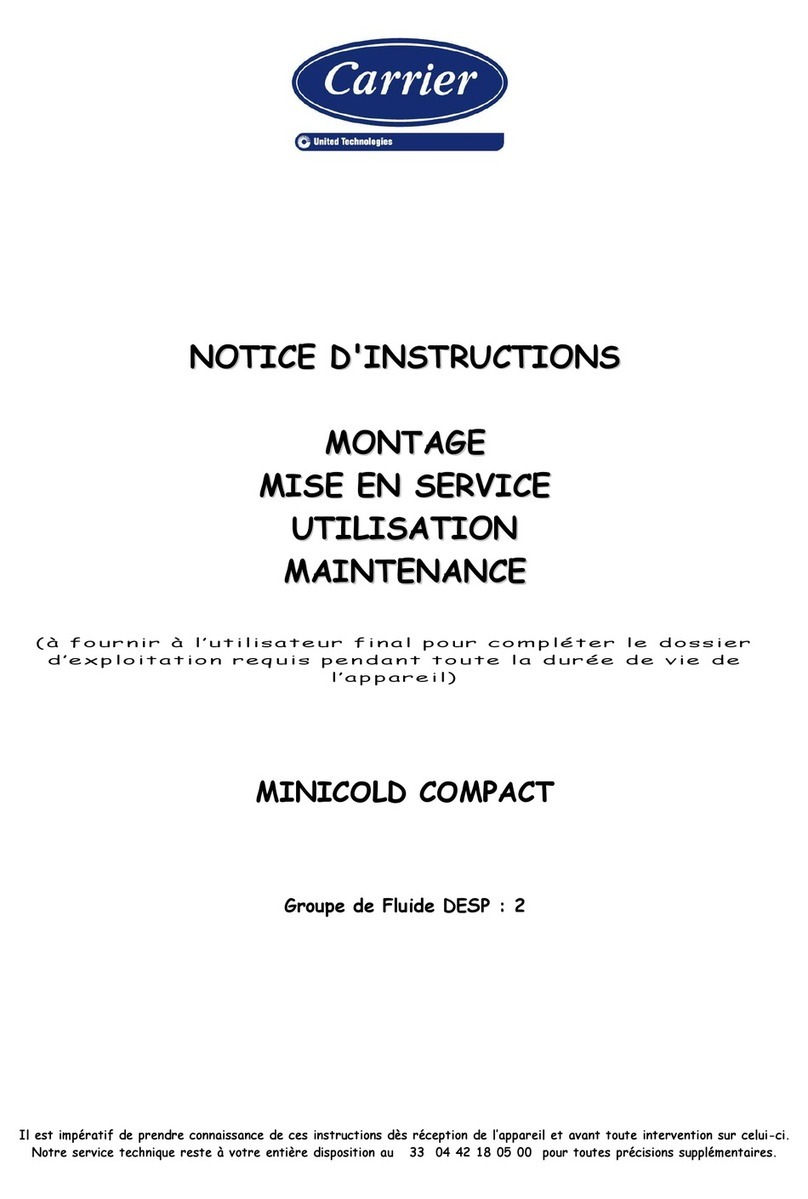
United Technologies
United Technologies Carrier MINICOLD COMPACT MCH 103 ZC operating instructions
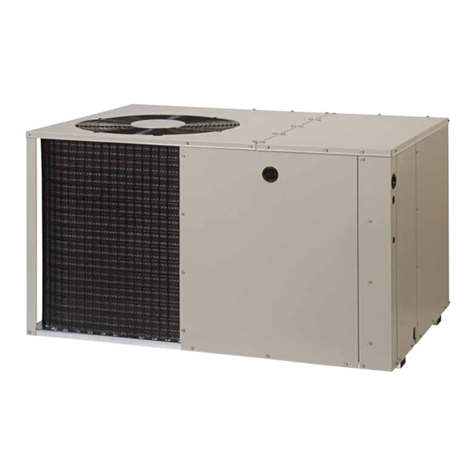
Heat Controller
Heat Controller TPRG Series installation instructions
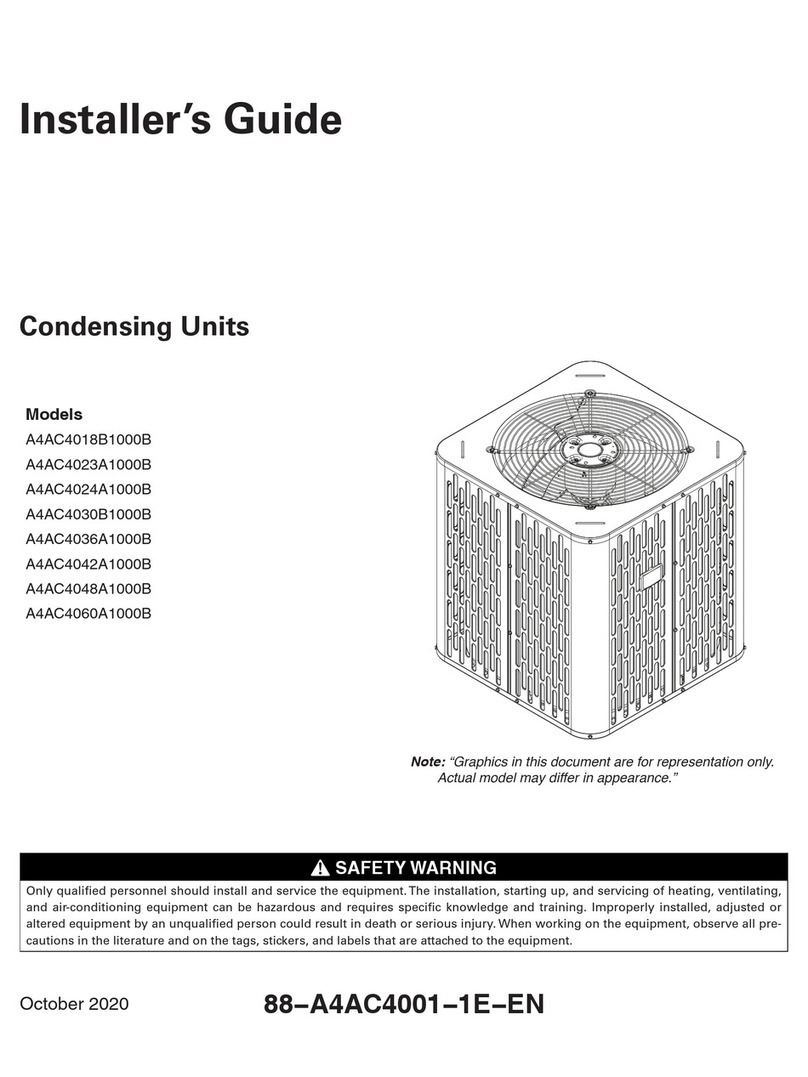
Ameristar
Ameristar A4AC4018B1000B Installer's guide



